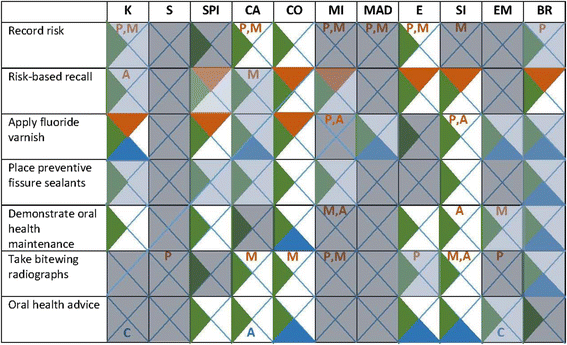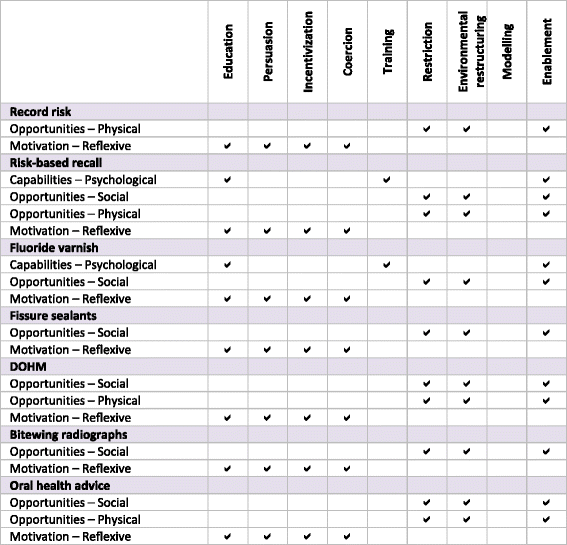Patient-, organization-, and system-level barriers and facilitators to preventive oral health care: a convergent mixed-methods study in primary dental care
- PMID: 26753791
- PMCID: PMC4710040
- DOI: 10.1186/s13012-015-0366-2
Patient-, organization-, and system-level barriers and facilitators to preventive oral health care: a convergent mixed-methods study in primary dental care
Abstract
Background: Dental caries is the most common chronic disease of adult and childhood, a largely preventable yet widespread, costly public health problem. This study identified patient-, organization-, and system-level factors influencing routine delivery of recommended care for prevention and management of caries in primary dental care.
Methods: A convergent mixed-methods design assessed six guidance-recommended behaviours to prevent and manage caries (recording risk, risk-based recall intervals, applying fluoride varnish, placing preventive fissure sealants, demonstrating oral health maintenance, taking dental x-rays). A diagnostic questionnaire assessing current practice, beliefs, and practice characteristics was sent to a random sample of 651 dentists in National Health Service (NHS) Scotland. Eight in-depth case studies comprising observation of routine dental visits and dental team member interviews were conducted. Patient feedback was collected from adult patients with recent checkups at case study practices. Key informant interviews were conducted with decision makers in policy, funding, education, and regulation. The Theoretical Domains Framework within the Behaviour Change Wheel was used to identify and describe patient-, organization-, and system-level barriers and facilitators to care. Findings were merged into a matrix describing theoretical domains salient to each behaviour. The matrix and Behaviour Change Wheel were used to prioritize behaviours for change and plan relevant intervention strategies.
Results: Theoretical domains associated with best practice were identified from the questionnaire (N-196), case studies (N = 8 practices, 29 interviews), and patient feedback (N = 19). Using the study matrix, key stakeholders identified priority behaviours (use of preventive fissure sealants among 6-12-year-olds) and strategies (audit and feedback, patient informational campaign) to improve guidance implementation. Proposed strategies were assessed as appropriate for immediate implementation and suitable for development with remaining behaviours.
Conclusions: Specific, theoretically based, testable interventions to improve caries prevention and management were coproduced by patient-, practice-, and policy-level stakeholders. Findings emphasize duality of behavioural determinants as barriers and facilitators, patient influence on preventive care delivery, and benefits of integrating multi-level interests when planning interventions in a dynamic, resource-constrained environment. Interventions identified in this study are actively being used to support ongoing implementation initiatives including guidance, professional development, and oral health promotion.
Figures






References
Publication types
MeSH terms
Grants and funding
LinkOut - more resources
Full Text Sources
Other Literature Sources
Medical

